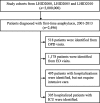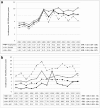Increasing trends of anaphylaxis-related events: an analysis of anaphylaxis using nationwide data in Taiwan, 2001-2013
- PMID: 30349617
- PMCID: PMC6178262
- DOI: 10.1186/s40413-018-0202-7
Increasing trends of anaphylaxis-related events: an analysis of anaphylaxis using nationwide data in Taiwan, 2001-2013
Abstract
Background: Anaphylaxis is a severe, potentially fatal, and systemic allergic reaction. Previous studies document increasing trends in incidence rates of anaphylaxis-related events in Western countries, yet little is known about the incidence and trend of anaphylaxis in Asia. In this study, we aimed to determine time trends in incidence rates of anaphylaxis-related events in Taiwan from 2001 through 2013.
Methods: We utilized medical claims data from the National Health Insurance Research Databases in Taiwan. We identified anaphylaxis-related events (ICD-9-CM-codes: 995.0, 995.60-995.69, 999.41-999.42, and 999.49) and calculated incidence rates. Poisson regression models were applied to examine trends and incidence rates.
Results: A total of 2496 patients (mean age, 45.11 years; 56% male) with first-time anaphylaxis were identified during 34,430,000 person-years of observation time. The overall incidence of anaphylaxis was 7.25 (95% confidence interval (CI) = 6.97-7.53) per 100,000 person-years, increasing from 4.79 in 2001 to 8.20 in 2013, with an incidence rate ratio (IRR) of 1.05 (95%CI = 1.04-1.06). Over the 13-year period, the increasing trends were found in incident diagnosis of anaphylaxis-related outpatient or emergency department visits (IRR = 1.06, 95%CI = 1.05-1.08) and admissions to intensive care units (IRR = 1.06, 95%CI = 1.03-1.10), whereas the trends in incidence of anaphylaxis-related hospitalizations remained steady. The proportion of patients requiring hospitalizations among all patients with anaphylaxis (p _trend = 0.01), as well as the proportion requiring intensive care treatment among patients who were hospitalized (p _trend = 0.01), both increased with age.
Conclusion: The incidence rate of anaphylaxis in Taiwan has increased at an average rate of 5% annually since 2001, paralleling the rising trends in several Western countries.
Keywords: Anaphylaxis; Asian; Epidemiology; Incidence; Time trends.
Conflict of interest statement
The Institutional Review Board of the National Health Research Institutes, Taiwan, approved this study protocol.Not applicable.The authors declare that they have no competing interest.Springer Nature remains neutral with regard to jurisdictional claims in published maps and institutional affiliations.
Figures




Similar articles
-
Trends in Childhood Anaphylaxis in Singapore: 2015-2022.Clin Exp Allergy. 2024 Aug;54(8):585-595. doi: 10.1111/cea.14528. Epub 2024 Jun 26. Clin Exp Allergy. 2024. PMID: 38923779
-
Increasing anaphylaxis events in Western Australia identified using four linked administrative datasets.World Allergy Organ J. 2020 Nov 13;13(11):100480. doi: 10.1016/j.waojou.2020.100480. eCollection 2020 Nov. World Allergy Organ J. 2020. PMID: 33294113 Free PMC article.
-
National trends in emergency department visits and hospitalizations for food-induced anaphylaxis in US children.Pediatr Allergy Immunol. 2018 Aug;29(5):538-544. doi: 10.1111/pai.12908. Epub 2018 May 30. Pediatr Allergy Immunol. 2018. PMID: 29663520
-
Population-based incidence of all-cause anaphylaxis and its development over time: a systematic review and meta-analysis.Front Allergy. 2023 Dec 12;4:1249280. doi: 10.3389/falgy.2023.1249280. eCollection 2023. Front Allergy. 2023. PMID: 38148907 Free PMC article. Review.
-
Epidemiology of anaphylaxis: is the trend still going up?Curr Opin Allergy Clin Immunol. 2023 Oct 1;23(5):349-356. doi: 10.1097/ACI.0000000000000933. Epub 2023 Aug 2. Curr Opin Allergy Clin Immunol. 2023. PMID: 37548324 Review.
Cited by
-
A Clinical Practice Guideline for the Emergency Management of Anaphylaxis (2020).Front Pharmacol. 2022 Mar 28;13:845689. doi: 10.3389/fphar.2022.845689. eCollection 2022. Front Pharmacol. 2022. PMID: 35418863 Free PMC article.
-
Global Trends in Anaphylaxis Epidemiology and Clinical Implications.J Allergy Clin Immunol Pract. 2020 Apr;8(4):1169-1176. doi: 10.1016/j.jaip.2019.11.027. Epub 2019 Nov 28. J Allergy Clin Immunol Pract. 2020. PMID: 31786255 Free PMC article.
-
Pediatric asthma comorbidities: Global impact and unmet needs.World Allergy Organ J. 2024 May 22;17(5):100909. doi: 10.1016/j.waojou.2024.100909. eCollection 2024 May. World Allergy Organ J. 2024. PMID: 38827329 Free PMC article. Review.
-
COVID-19 vaccine safety: Background incidence rates of anaphylaxis, myocarditis, pericarditis, Guillain-Barré Syndrome, and mortality in South Korea using a nationwide population-based cohort study.PLoS One. 2024 Feb 21;19(2):e0297902. doi: 10.1371/journal.pone.0297902. eCollection 2024. PLoS One. 2024. PMID: 38381729 Free PMC article.
-
Investigation of the underuse of adrenaline (epinephrine) and prognosis among patients with anaphylaxis at emergency department admission.Front Med (Lausanne). 2023 Jul 7;10:1163817. doi: 10.3389/fmed.2023.1163817. eCollection 2023. Front Med (Lausanne). 2023. PMID: 37484849 Free PMC article.
References
-
- Sampson HA, Munoz-Furlong A, Campbell RL, Adkinson NF, Jr, Bock SA, Branum A, et al. Second symposium on the definition and management of anaphylaxis: summary report--second National Institute of allergy and infectious disease/Food Allergy and Anaphylaxis Network symposium. J Allergy Clin Immunol. 2006;117:391–397. doi: 10.1016/j.jaci.2005.12.1303. - DOI - PubMed
Grants and funding
LinkOut - more resources
Full Text Sources

